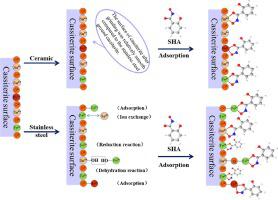Minerals Engineering ( IF 4.9 ) Pub Date : 2021-04-23 , DOI: 10.1016/j.mineng.2021.106919 Yang Cao , Xiong Tong , Xian Xie , Qiang Song , Wenjie Zhang , Yunpeng Du , Shengdong Zhang

|
Grinding plays an important role in the beneficiation process. Different grinding media can determine the size distribution, shape, and even the surface properties of the produced material. However, comprehensive research related to the effect of grinding media on the flotation performance of cassiterite is lacking. In the current study, the effects on the flotability of the products obtained by grinding with ceramic and stainless steel media were investigated using micro-flotation, laser particle size distribution analysis, inductively coupled plasma optical emission spectroscopy (ICP-OES), chemical element analysis, zeta potential measurements, field emission scanning electron microscopy-energy dispersive spectroscopy (FESEM-EDS), and X-ray photoelectron spectroscopy (XPS). The micro-flotation results demonstrate that the flotability of stainless steel ground cassiterite surpasses that of ceramic. The laser particle size distribution test reveals that the two grinding media do not have a strong impact on the particle size distribution. The ICP-OES and chemical element analysis results identify the higher iron content in the samples and pulp of stainless steel ground cassiterite as the principle influencing factor. The zeta potential analysis indicates that the dissolved iron ions absorbed on the cassiterite surface results in a positive shift of the mineral surface potential. This not only reduces electrostatic repulsion but also increases the active sites of salicylhydroxamic acid (SHA) chemisorption. FESEM-EDS results demonstrate the rougher surface and higher iron content of the stainless steel ground cassiterite compared to the ceramic ground cassiterite, thereby increasing the SHA adsorption. The stainless steel grinding cassiterite was observed to alter the chemical environment of Fe species on the cassiterite surface via XPS analysis, with Fe2+ exhibiting a stronger reactivity and stability towards SHA compared to Fe3+. Thus, the stainless steel media ground cassiterite demonstrates an improved flotability performance compared to the ceramic equivalent.
中文翻译:

研磨介质对锡石浮选性能的影响
磨矿在选矿过程中起着重要作用。不同的研磨介质可以确定所生产材料的尺寸分布,形状,甚至表面特性。然而,缺乏与研磨介质对锡石浮选性能影响有关的综合研究。在当前的研究中,使用微浮选,激光粒度分布分析,电感耦合等离子体发射光谱(ICP-OES),化学元素分析,研究了通过陶瓷和不锈钢介质研磨而获得的产品对浮选性的影响。 ,ζ电势测量,场发射扫描电子显微镜-能量色散光谱(FESEM-EDS)和X射线光电子能谱(XPS)。微浮选结果表明,不锈钢磨碎的锡石的浮选性优于陶瓷。激光粒度分布测试表明,两种研磨介质对粒度分布没有强烈影响。ICP-OES和化学元素分析结果表明,不锈钢磨碎的锡石样品和纸浆中的铁含量较高,这是主要的影响因素。ζ电势分析表明,吸附在锡石表面上的溶解的铁离子导致矿物表面电势正移。这不仅减少了静电排斥,而且增加了水杨基异羟肟酸(SHA)化学吸附的活性位。FESEM-EDS结果表明,与陶瓷磨锡石相比,不锈钢磨锡石的表面更粗糙,铁含量更高,从而增加了SHA的吸附。通过XPS分析,观察到不锈钢研磨锡石改变了锡石表面上的Fe物种的化学环境,其中Fe2+呈现对SHA更强的反应性和稳定性相比的Fe 3+。因此,与陶瓷等效物相比,不锈钢介质研磨的锡石表现出改进的浮选性能。











































 京公网安备 11010802027423号
京公网安备 11010802027423号